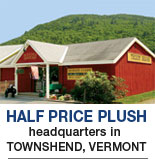
Pincushion Doll
A friend just showed me a Mary Meyer pincushion she has thats over 70 years old.
My Mother was Mary Meyer and she started a company that manufactured pincushions dolls in the 1930s and today is still manufacturing stuffed toys and dolls – 70+ years later.
During the late1930s Mary Meyer made animal pincushions and dolls. Women who sewed used them to store their pins and needles in. In the 1930s women sewed most of their own dresses. For generations women kept their needles in Tomato pincushiosn. Mary Meyer (my Mother) changed the design from the Tomato pincushion to stuffed dolls and stuffed Scotties and other small animals.
The pincushion doll I have today was made in the late 1930s. It’s made of colorful cotton fabric and stuffed with garnetted cotton, deorated with 5 brass safety pins and a Blue satin ribbon. My Dad – Hans Meyer- was the sales organization that travelled the eastern USA and called on department stores and 5 & 10¢ chain stores. Woolwworth, WT Grant and the other chains would order 1, 2 or 3 dozen assorted of Mom and Dad’s pincushions for 40 or 50 stores.
Dad loved to visit Marshall Field in Chicago and the Hecht Co or Woodward & Lothrop in Washington, DC or Jordan Marsh in Boston. These stores bought his pincushions for their Notion or Women’s Sewing departments.
The Blue check pincushion doll I just found was made in the late 1930s. The body is made of cotton percale fabric and stuffed with cotton. The silk-screened face we purchased from Crescent Hill Novelty Co. in New York City. Also part of the doll were 5 brass safety pins and a satin neck ribbon.
On the top of the dolls head is a cloth loop that is used to hang the doll. Some of the dolls had a White apron and some did not. Why? I have no idea. I was about 9 years old at the time and pincushions were the least of my interests. But being part of a business family exposed me to discussions between Mom and Dad – the maker and designer and her major salesman – at the dinner table. I helped out in the factory. I remember seeing and hearing about pincushions and the business. I absorbed facts even though I was not interested in them.
Today I am looking for for Doll Pincushions. After 70+ years I have found 7 pincushion dolls Mary Meyer made. How many did they manufacture over about a 5 to 8 year period in the very late 1930s? I guess probably about 5,000 pieces.
The first one my daughter found in Larned, Kansas about 5 yearsd ago. She bought it on the web. Since then we have found 6 more. The first two dolls had a “Mary Meyer – Hand Made Pincushion” Blue and Gold paper hang-tag on them. The last 4 have no tags, but are identical to the ones with the tags.
My goal today is to look for more Pincushion dolls and to see if I can dig out any history of the doll. Mary Made in the area of 5,000 Dolls and we have 7 of them There are 4,993 more dolls out there waiting to be found.
Did your mother’s or grandmother have a pincushion my mother might have made? Where and when did she buy it? Can you tell me anything about it? Chances are I am not going to find out much history, but I have to try. Antique shops and websites may have the dolls I am looking for. Some will be in great shape. Others will be in awful condidion, but I have to look for them. I’m 82 years old. I may not be here too many more years and whaat I remember will be lost when I’m gone.
Do you happen to have a Pincushion Doll in your attic? Do you have a Scotty or a Lamb pincushion that was passed down to you? We have found them in Kansas, Florida and in New England.
If you do, please tell me about it. You can email me. I would love to hear about it and anything you can tell me of it’s history.
by Walter Meyer
Mary Meyer Stuffed Toys
Townshend, Vermont
walter_meyer@marymeyer.com
Share This Post:
 The first piece had a sound chip in it that played “Happy Birthday to You” when squeezed. The other made a rattle, a squeak or a crinkle sound when squeezed. Each piece had a fabric candle and a fabric flame as part of it.
The first piece had a sound chip in it that played “Happy Birthday to You” when squeezed. The other made a rattle, a squeak or a crinkle sound when squeezed. Each piece had a fabric candle and a fabric flame as part of it.












